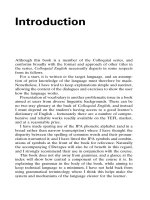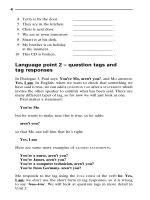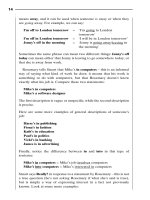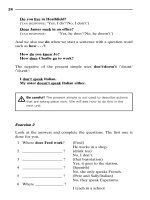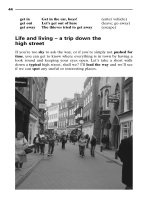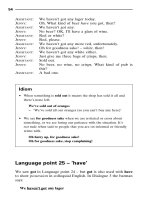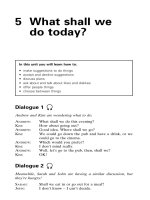A complete English language course part 2
Bạn đang xem bản rút gọn của tài liệu. Xem và tải ngay bản đầy đủ của tài liệu tại đây (112.4 KB, 10 trang )
Introduction
Although this book is a member of the Colloquial series, and
conforms broadly with the format and approach of other titles in
the series, Colloquial English necessarily departs in some respects
from its fellows.
For a start, it is written in the target language, and an assump-
tion of prior knowledge of the language must therefore be made.
Nonetheless, I have tried to keep explanations simple and succinct,
allowing the context of the dialogues and exercises to show the user
how the language works.
Presentation of vocabulary is another problematic issue in a book
aimed at users from diverse linguistic backgrounds. There can be
no two-way glossary at the back of Colloquial English, and instead
I must depend on the student’s having access to a good learner’s
dictionary of English – fortunately there are a number of compre-
hensive and reliable works readily available on the TEFL market,
and at a reasonable price.
I have made sparing use of the IPA phonetic alphabet (and in a
broad rather than narrow transcription) where I have thought the
disparity between the spelling of common words and their pronun-
ciation warranted it; and I have listed the IPA symbols and combin-
ations of symbols at the front of the book for reference. Naturally
the accompanying CDs/tapes will also be of benefit in this regard,
and I strongly recommend their use in conjunction with the course.
This book does not shy away from grammar, and a glance at the
index will show how central a component of the course it is. In
explaining the grammar in the body of the book, while aiming to
keep technical language to a minimum, I have not held back from
using grammatical terminology where I think this helps make the
system and mechanisms of the language clearer for the learner.
English spelling
You will see that sometimes phonetic symbols have been used to
help you with pronunciation in this book. This is because English
spelling (like French and Danish, and unlike German and Russian)
is a historic rather than a phonetic system, which means that it does
not always correspond very well to pronunciation – the words
have changed in sound while the old spelling has stayed the same.
This is a difficulty for people learning English, but it is something
that must be accepted from the start – you will have to learn
pronunciations as well as spellings. But the important thing to
remember is that English spelling does have a system – it isn’t com-
pletely illogical. It’s just that the system is sometimes a bit more
complicated than you might expect, and there are a lot of apparent
exceptions to rules.
For example, we use a ‘silent e’ as a regular component of the
system: a silent e after a single consonant changes the sound of
the vowel before the consonant: pan /pn/ but pane /pεin/; hop /hɔp/
but hope /həυp/. And sometimes we spell the same sound in
different ways – look at the different possible spellings there are for
/ɑi/: my
night time
; and for /əυ/: ho
le throw boat only soul. Or (to
take an extreme example) look at the different pronunciations of
the combination -ough: through /θru/ though /ðəυ/ bough /bɑu/
bought /bɔt/ cough /kɔf/ enough /`nf/. But don’t worry – millions
of people learn English all over the world, and they all manage
pretty well with the spelling, because the more contact you have
with the language, the easier it is. If you approach this aspect of
English with a positive frame of mind, you’ll be surprised how
quickly you get used to it!
1111
2
3
4
5
6
7
8
9
10
11
1211
13
14
15
16
17
18
19
20
21
22
23
24
25
26
27
28
29
30
31
32
33
34
35
36
37
38
39
40
41
4211
IPA symbols
Vowels Consonants
/ə/ butter, sofa /b/ book, able
// cat, hand /k/ come, look
/ɑ/ father, farm // children, which
/ε/ get, send /d/ red, down
// sit, win /f/ fall, if
/i/ happy // go, leg
/i/ feel, machine // Gerry, Jenny
/ɔ/ long, top /h/ have, hand
/ɔ/ fall, thought /l/ look, milk
/υ/ full, book /m/ man, come
/u/ do, cool /n/ now, run
// cup, some /ŋ/ bring, running
// bird, hurt /p/ paper, cup
/kw/ quite, quick
/r/ red, arrive
Diphthongs
/
r
/ car, four
†
/εi/ say, eight /s/ send, miss
/ɑi/ my, night /ʃ/ should, wish
/ɔi/ boy /t/ it, time
/əυ/ boat, home /θ/ think, three
/ɑu/ now, found /ð/ the, with
/ə/ hear, here /v/ very, give
/εə/ hair, where /w/ want, when
/υə/ sure /j/ yes, you
/z/ prize, rose
/`/ (precedes stressed syllable) // measure
†
silent before consonant and at end of sentence
Grammatical terms
used in this book
action verb – a verb that describes a dynamic action or event: run,
read, throw, phone.
active – a sentence structure where the doer of the action is the
subject: the dog
bit the postman.
adjective – a word that describes a noun: red, heavy, electronic,
difficult.
adverb – a word that describes how, where or when an action or
event takes place: quickly, here, tomorrow.
auxiliary – a special verb that is used with another (main) verb:
I was
going, he didn’t come; compare modal auxiliary.
base-form – the normal dictionary form of the verb, without any
endings: come, go, study, drive, stop.
C1 – a type of conditional tense: if he arrives late.
C2 – a type of conditional tense: if he arrived late.
clause – a part of a sentence that includes a verb.
comparative – the form of the adjective that shows a higher degree:
cheaper, bigger, more expensive.
conditional – a tense of the verb that indicates hypothetical
situations: I’d read a book. There are two main conditional
tenses in English: C1 and C2.
consonant – in writing, the following letters: b c d f g h j k l m n p q
r s t v w x y z; compare vowel. But consonant sounds can
sometimes be written as vowels: u
niversity.
definite article – the word the.
degree words – words that describe the degree of an adjective: very
small, quite expensive, awfully clever.
direct object – the person or thing that receives the action of the
verb: we saw the concert
.
direct speech – the actual words someone said, put in the sentence
as a quote: She said: He isn’t coming; compare reported speech.
1111
2
3
4
5
6
7
8
9
10
11
1211
13
14
15
16
17
18
19
20
21
22
23
24
25
26
27
28
29
30
31
32
33
34
35
36
37
38
39
40
41
4211
ed-form – the regular past tense form of the verb: smiled, stopped,
studied, asked.
empty it – in some sentence structures, an it that doesn’t refer to
anything specific, but is required for grammatical reasons: it’s
raining, it’s nice to see you.
full form – see short form.
future – a tense of the verb – there are three main ways of doing the
future in English: I will write, I’m writing, I’m going to write.
genitive – a form of the noun denoting possession or relationship:
John’s
book, the middle of the road.
indefinite article – the word a/an.
indirect object – the person or thing that receives the direct object
of the verb: we gave the girl
(
INDIRECT OBJECT
) a book
(
DIRECT
OBJECT
).
indirect speech – another term for reported speech.
ing-form – the form of the verb ending in -ing: coming, going,
studying, driving, stopping; used in the continuous tenses, and
in other ways.
irregular verb – a verb that doesn’t form its past simple tense by
adding -ed: flew (fly), came (come), went (go), made (make).
modal auxiliary – special auxiliary verbs that have their own
meanings, but are used with other verbs: he can
speak English,
you shouldn’t
go.
negative – the form of the verb that tells you that something doesn’t,
didn’t or won’t happen.
noun – a word that names a thing, person, place or idea: cat, James,
London, honesty.
object – the thing or person that receives the action in a sentence:
Liz fed the cats
; compare subject.
passive – a sentence structure where the receiver of the action is the
subject: the postman
was bitten by the dog; compare active.
past continuous – a tense of the verb that indicates ongoing action
in the past: I was reading.
past participle – the form of the verb used with have to form the
present perfect tense: I’ve arrived
, she’s gone.
past perfect – a tense of the verb one stage back in the past from the
present perfect: I had broken my leg.
past simple – a tense of the verb that indicates completed action in
the past: I stopped.
phrasal verb – a combination of verb + adverb which has a special
meaning: blow up, turn off, take off.
xiv

